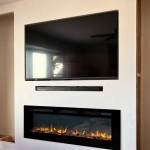Honeywell Thermocouples for Gas Fireplaces: Function, Selection, and Maintenance
A gas fireplace offers a convenient and aesthetically pleasing alternative to traditional wood-burning fireplaces. A critical component ensuring the safe and reliable operation of a gas fireplace is the thermocouple. The thermocouple is a safety device that monitors the pilot flame and, if the pilot flame is extinguished, shuts off the gas supply to prevent a dangerous buildup of unburned gas. Honeywell is a widely recognized manufacturer of thermocouples, offering a range of options designed to meet the needs of various gas fireplace models.
The thermocouple operates based on the "Seebeck effect," a phenomenon where a temperature difference between two dissimilar metal conductors in a circuit produces a voltage. In a gas fireplace, the thermocouple consists of two wires made of different metals, typically iron and constantan or chromel and alumel, joined at one end, forming the "hot junction." This hot junction is placed in the pilot flame. When heated by the flame, a small voltage is generated. This voltage is then used to keep the gas valve open, allowing gas to flow to the main burner. If the pilot flame goes out, the hot junction cools, the voltage drops to zero, and the gas valve closes, cutting off the gas supply.
The Honeywell thermocouple is designed for durability and reliable performance in the harsh environment of a gas fireplace. However, like any mechanical or electrical component, it can eventually fail. Understanding how to select the correct replacement Honeywell thermocouple and perform basic maintenance can significantly extend the lifespan of your gas fireplace and ensure its safe operation.
Understanding the Importance of Thermocouple Length and Thread Size
Selecting the correct replacement Honeywell thermocouple is crucial for ensuring proper operation. Two primary considerations are the length and thread size of the thermocouple. The length of the thermocouple must be sufficient to reach the pilot burner assembly and securely connect to the gas valve. An excessively short thermocouple may not reach the pilot flame, preventing it from generating the necessary voltage to keep the gas valve open. Conversely, an excessively long thermocouple may be difficult to install and could be susceptible to damage.
The thread size of the thermocouple is equally important. The threads must match those on the gas valve to ensure a secure and leak-proof connection. Using an incorrectly sized thread can lead to gas leaks, which are extremely dangerous. Honeywell thermocouples are typically available with standard thread sizes such as 11/32-32 or M9 x 1.0. Before purchasing a replacement, carefully inspect the existing thermocouple and the gas valve to determine the correct thread size. It is often helpful to consult the gas fireplace manufacturer's manual for specific recommendations.
When the thermocouple fails, the most common symptom is the inability to keep the pilot light lit. Even after repeated attempts to light the pilot, it will extinguish as soon as the pilot light button is released. This indicates that the thermocouple is not generating sufficient voltage to hold the gas valve open.
Identifying and Addressing Common Thermocouple Problems
Several factors can contribute to thermocouple failure. One common issue is corrosion or oxidation of the hot junction, which can reduce its ability to generate voltage. Soot or carbon deposits on the thermocouple can also insulate it from the heat of the pilot flame, hindering its performance. Physical damage to the thermocouple, such as kinks or breaks in the wire, can also prevent it from functioning correctly.
Before replacing the thermocouple, it is advisable to perform some basic troubleshooting steps. First, inspect the pilot burner assembly to ensure that it is clean and free of debris. A clogged pilot burner can prevent the pilot flame from reaching the thermocouple effectively. Use a small brush or compressed air to clean the pilot burner opening. Next, examine the thermocouple for any signs of physical damage or corrosion. If the thermocouple appears to be dirty, gently clean it with a fine-grit sandpaper or steel wool.
If cleaning and inspection do not resolve the issue, the thermocouple may need to be tested with a multimeter. A multimeter can measure the voltage output of the thermocouple when exposed to the pilot flame. A healthy Honeywell thermocouple should produce a voltage reading within the range specified by the manufacturer. If the voltage reading is significantly lower than the specified range, the thermocouple is likely faulty and needs to be replaced.
Proper Installation and Preventative Maintenance for Honeywell Thermocouples
Installing a new Honeywell thermocouple is a relatively straightforward process, but it is essential to follow safety precautions. Before beginning any work on the gas fireplace, turn off the gas supply at the main shut-off valve. Allow the fireplace to cool completely before attempting to remove the old thermocouple. Disconnect the old thermocouple from the gas valve and carefully remove it from the pilot burner assembly.
Install the new Honeywell thermocouple by inserting it into the pilot burner assembly and connecting it to the gas valve. Ensure that the threads are properly aligned and that the connection is securely tightened. Do not overtighten the connection, as this can damage the threads. Once the new thermocouple is installed, turn the gas supply back on and relight the pilot flame according to the manufacturer's instructions.
Preventative maintenance can significantly extend the lifespan of the Honeywell thermocouple and ensure the reliable operation of the gas fireplace. Regularly inspect the pilot burner assembly and clean it as needed to remove any debris or soot buildup. Periodically check the thermocouple for signs of corrosion or damage and clean it accordingly. Additionally, it is advisable to have the gas fireplace professionally inspected and serviced annually to ensure that all components, including the thermocouple, are functioning correctly.
Proper installation and maintenance of the Honeywell thermocouple, along with routine cleaning of the pilot light assembley, can prevent common issues and allow for safe operation and an extended lifespan of the gas fireplace. Selecting the right thermocouple and installing it per the manufacturer's instructions is of vital importance.

Thermocouple Honeywell Valve

Honeywell Thermocouple My Fireplace S

Honeywell Thermocouple 900mm Q309a 2788 New

Temperature Sensor Gas Stove Elbow Head Thermocouple 600mm For Fireplace Range China Heating Element Made In Com

Honeywell Thermocouple 30 Cq100a1039 U Rona

Diy Furnace Repair Replacing Thermocouple

Replacement Gas Thermocouple For Honeywell Q309a 26265

18 Universal Thermocoupling Hechler S Mainstreet Hearth Home Troy Missouri

High Temp Lp Thermocouple 05 07 00084 Fire Parts Ca

Premium Quality Thermocouple For Gas Fireplace Heater Temperature Regulation
Related Posts








